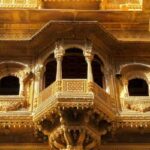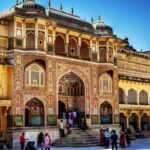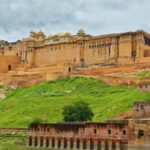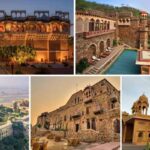Top 10 Cultural Heritage of Rajasthan, a jewel in India’s cultural crown, boasts a heritage steeped in history, art, and tradition. Its fortified cities and opulent palaces, such as Amer Fort in Jaipur and Mehrangarh Fort in Jodhpur, stand as living testaments to the grandeur of Rajput architecture. These architectural marvels exhibit intricate carvings, sprawling courtyards, and ornate facades, reflecting the opulence of Rajasthan’s past rulers.
The Thar Desert, a defining geographical feature, has shaped a unique desert culture. Camel safaris through the golden sands are a popular way to experience this arid expanse, immersing travelers in a world of vibrant music, dance, and attire. Rajasthani cuisine, renowned for its fiery flavors, offers distinctive dishes like Dal Baati Churma and Gatte ki Sabzi, reflecting the resourcefulness born of the state’s harsh climate.
Traditional clothing in Rajasthan is a riot of color, with women donning ghagra cholis and odhnis, while men wrap themselves in intricately tied turbans known as pagris. The state’s craftsmen are renowned for their intricate jewelry, often adorned with silver, gold, and precious stones, showcasing exceptional artistry.
Rajasthan’s cultural landscape resonates with the melodies of folk music and the rhythms of dance. The graceful movements of Ghoomar, the sinuous twirls of Kalbelia, and the lively storytelling of Kathputli are intrinsic to the state’s artistic heritage. These performances are accompanied by an array of traditional instruments, including the dholak, sarangi, and morchang.
Puppetry, a captivating form of storytelling, finds its roots in Rajasthan Tourism. The state’s puppeteers skillfully bring intricate marionettes to life, weaving tales of folklore and legend. Additionally, Rajasthan is a haven for crafts like block printing, tie-dyeing (bandhani), and pottery, each a testament to the skill and creativity of its artisans.
Festivals like the Pushkar Camel Fair and the Jaipur Literature Festival showcase the vibrant tapestry of Rajasthan’s culture, attracting visitors from around the world. The state’s wildlife sanctuaries, including Ranthambore and Sariska, harbor an array of species, from the majestic Bengal tiger to a diverse range of avian life Tourist Places Rajasthan.
Lastly, Rajasthan’s rich tradition of miniature paintings, depicting scenes from epics, folklore, and nature, are cherished artistic expressions that have been passed down through generations. These paintings serve as visual chronicles of the state’s cultural heritage, embodying the creativity and artistry of its people. In every facet of life, from architecture to art, Rajasthan’s cultural heritage is a testament to the enduring spirit and creativity of its people.
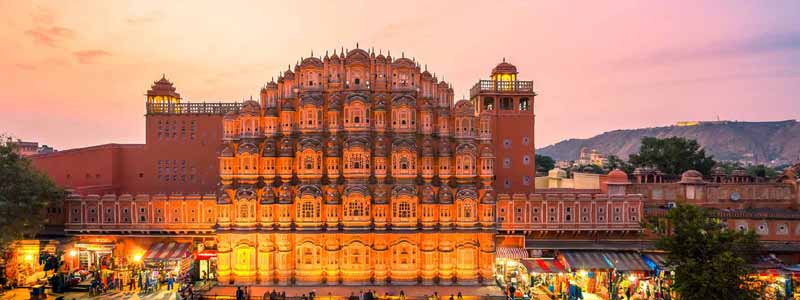
Jaipur – The Pink City
Jaipur, known as the Pink City, is a mesmerizing gem nestled in the heart of Rajasthan, India. This historic city earned its nickname when it was painted pink in 1876 to welcome the Prince of Wales, a tradition it has since retained.
Stepping into Jaipur is like stepping back in time. The city’s architecture is a breathtaking fusion of Rajput and Mughal styles, evident in its palaces, forts, and intricate havelis. The crown jewel is the Hawa Mahal, a five-story palace with an enchanting facade of 953 windows, allowing royal ladies to observe the bustling streets without being seen.
The Amer Fort, perched majestically on a hill, is a testament to Jaipur’s regal history. Its grandeur is unmatched, with sprawling courtyards, mirrored halls, and sweeping views of the surrounding Aravalli hills.
The City Palace, an opulent complex, houses museums showcasing the rich cultural heritage of the region. Jantar Mantar, an ancient observatory, boasts of immense astronomical instruments that continue to baffle modern scientists.
The vibrant markets of Jaipur are a riot of color and energy. From the bustling Johari Bazaar to the artisanal delights of Bapu Bazaar, they offer a treasure trove of textiles, jewelry, and handicrafts.
Jaipur’s cultural tapestry is woven with folk music, dance, and a delectable cuisine. Its warmth and hospitality are as legendary as its history. The Pink City is not just a place; it’s an experience, an immersion into a world of grandeur and tradition.
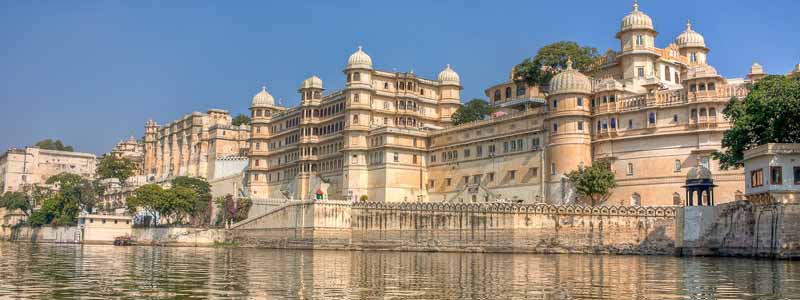
Udaipur – The City of Lakes
Udaipur, often referred to as “The City of Lakes,” is a mesmerizing gem in the heart of Rajasthan, India. Nestled amidst the Aravalli Range, this enchanting city boasts an intricate tapestry of history, culture, and natural beauty.
The centerpiece of Udaipur’s charm lies in its pristine lakes, including Lake Pichola, Fateh Sagar Lake, and Udai Sagar Lake. These shimmering water bodies are surrounded by majestic palaces, serene gardens, and ornate temples, creating a captivating blend of architecture and nature. The Lake Palace, seemingly floating on Lake Pichola, is a prime example of the city’s architectural splendor.
Udaipur’s rich heritage is evident in its splendid palaces and forts, such as the City Palace and the Jag Mandir, each telling tales of valor and grandeur. The city is also renowned for its colorful markets, where you can shop for exquisite handicrafts, jewelry, and textiles.
The vibrant culture of Udaipur comes to life during festivals like Diwali and Holi, with traditional music and dance performances that add to the city’s allure.
Udaipur is not just a destination; it’s an experience that leaves a lasting impression on every traveler. Its serene lakes, opulent palaces, and warm hospitality make it a must-visit for anyone seeking a taste of India’s royal heritage and natural beauty.
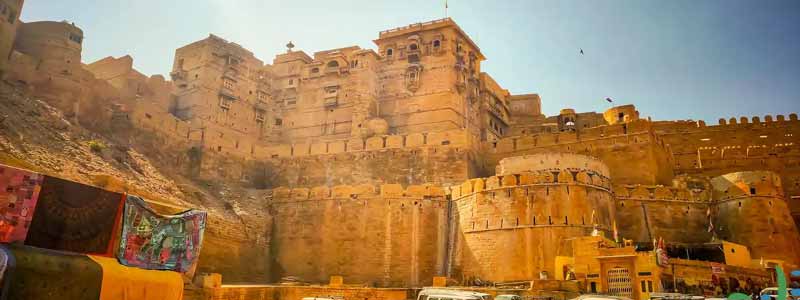
Jaisalmer – The Golden City
Jaisalmer, often referred to as “The Golden City,” is a mesmerizing desert oasis located in the northwestern state of Rajasthan, India. This enchanting city gets its nickname from the stunning golden sandstone used to construct its magnificent architecture, giving it a warm, golden glow that shimmers in the sunlight.
The crown jewel of Jaisalmer is the majestic Jaisalmer Fort, a UNESCO World Heritage Site. This imposing fortress rises like a golden mirage from the Thar Desert and is a testament to the city’s rich history. Inside the fort, you’ll find a labyrinth of narrow winding streets, exquisite havelis (traditional mansions), and vibrant markets selling intricate handicrafts, textiles, and jewelry.
Jaisalmer is also known for its mesmerizing desert landscapes, with the Sam Sand Dunes being a must-visit. Here, you can experience the quintessential desert safari, riding on camelback across the undulating dunes as the sun sets, painting the sands in hues of gold and orange.
The city’s culture comes alive with traditional Rajasthani music and dance performances, and its cuisine is a delightful blend of flavors, with dishes like dal baati churma and gatte ki sabzi being local specialties.
Jaisalmer is a place where history, culture, and natural beauty converge, offering a golden opportunity to immerse yourself in the magic of Rajasthan’s desert life.
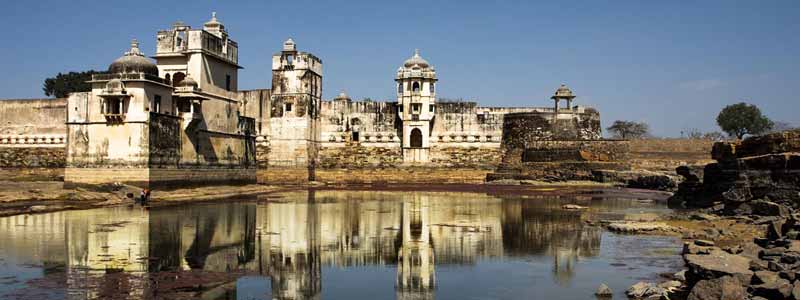
Chittorgarh – Saga of Valor
Chittorgarh, a city in Rajasthan, India, is steeped in history and is often referred to as the “Saga of Valor.” Its historical significance lies in its role as the capital of the Mewar kingdom, known for its tales of courage, sacrifice, and unwavering valor.
One of the most renowned stories is that of Rani Padmini, whose legendary beauty led to a siege by Alauddin Khilji. Rather than surrendering, the Rajput warriors chose to perform “jauhar,” a mass self-immolation to protect their honor.
Chittorgarh’s fort, one of the largest in India, stands as a testament to the city’s resilience. It has witnessed numerous battles and endured countless sieges, but it has never fallen to an enemy. Its architecture, including the iconic Vijay Stambha (Tower of Victory) and Kirti Stambha (Tower of Fame), reflects the artistic and military prowess of the Rajputs.
Chittorgarh’s history is a tapestry of heroism, where Rajput rulers and warriors displayed unmatched valor in defense of their land, culture, and honor. Today, the city’s rich heritage attracts visitors from around the world, offering a glimpse into the enduring spirit of Chittorgarh – a saga of valor that continues to inspire generations.
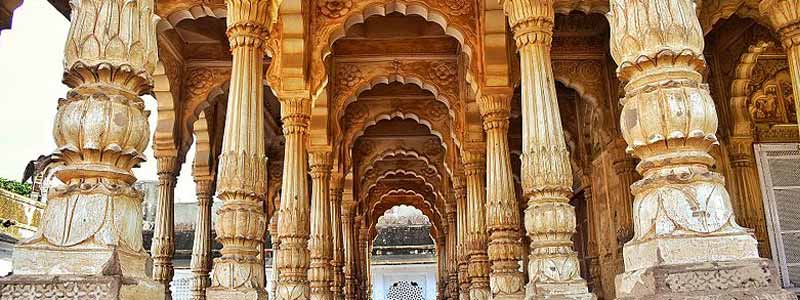
Jodhpur – The Blue City
Jodhpur, often referred to as “The Blue City,” is a mesmerizing destination in the heart of Rajasthan, India. This historic city is renowned for its distinctive architecture and the enchanting sea of blue-painted buildings that adorn its streets.
The origins of Jodhpur’s blue color are rooted in tradition and symbolism. The Brahmin residents of the city traditionally painted their homes blue to symbolize their connection to Lord Shiva, the Hindu god associated with the color. Over time, this practice spread, and today, the entire old town is bathed in shades of blue.
Wandering through the labyrinthine streets of Jodhpur is like stepping into a surreal dreamscape. The azure buildings create a unique and ethereal atmosphere, casting a soothing spell on visitors. The vibrant hues contrast beautifully against the arid desert landscape that surrounds the city.
Jodhpur’s crowning jewel is the magnificent Mehrangarh Fort, an imposing structure that looms over the cityscape. This fort, with its intricate carvings, expansive courtyards, and sweeping views of the city below, is a testament to the architectural grandeur of Rajasthan.
In addition to its architectural wonders, Jodhpur offers a rich tapestry of culture, history, and hospitality. The bustling bazaars, the aromatic flavors of Rajasthani cuisine, and the warm smiles of its people all contribute to the city’s timeless charm. Jodhpur, The Blue City, is a place where tradition meets modernity, creating an unforgettable experience for every traveler.
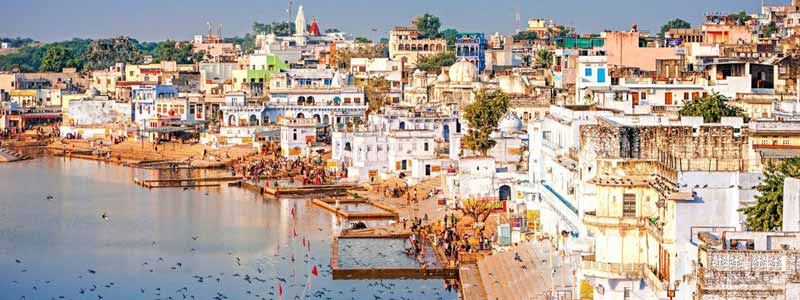
Pushkar – The Spiritual Hub
Pushkar, nestled in the heart of Rajasthan, India, is a magnetic spiritual hub that beckons seekers and pilgrims from across the globe. This ancient town cradles the sacred Pushkar Lake, said to be formed by a lotus flower dropped by Lord Brahma, the creator in Hindu mythology.
Surrounded by fifty-two ghats and flanked by temples, the lake is the epicenter of spiritual fervor. Bathing in its holy waters is believed to cleanse the soul of sins. The Brahma Temple, dedicated to the deity, is a rare gem, as Brahma temples are scarce in India.
Pushkar’s air resonates with devotional chants, and its narrow streets echo with the melody of bells and hymns. The annual Pushkar Fair transforms the town into a vibrant carnival, where traders, pilgrims, and curious travelers converge. Here, camels, the ships of the desert, are venerated, traded, and raced in a spectacular display of culture.
The vibrant marketplaces brim with colorful textiles, handicrafts, and trinkets, offering a sensory journey through Rajasthan’s rich heritage. The town’s spiritual energy seeps into every visitor, fostering introspection and serenity.
Pushkar is not just a destination; it’s an experience that transcends the physical realm, leaving an indelible mark on the hearts of those who venture into its sacred embrace.
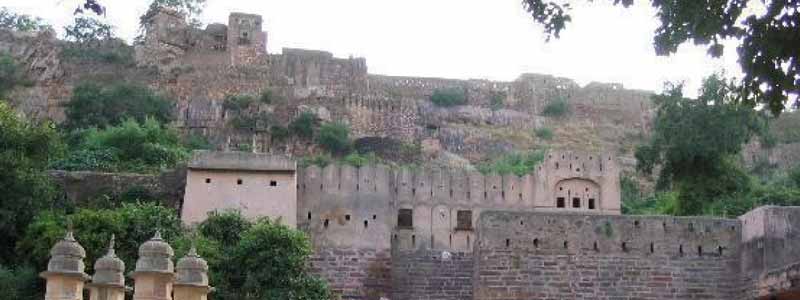
Ranthambore – Where Nature Meets Heritage
Ranthambore National Park, nestled in the heart of Rajasthan, India, is a captivating blend of nature and heritage. Spread over 1,334 square kilometers, it is a testament to the harmonious coexistence of wildlife and ancient architectural marvels.
This sanctuary is renowned for its population of majestic Bengal tigers, making it one of the best places in the world for tiger sightings. The lush deciduous forests, scenic lakes, and rugged terrain provide a picturesque backdrop to this vibrant ecosystem.
Amidst this natural splendor lies the historic Ranthambore Fort, a UNESCO World Heritage site. This formidable structure dates back to the 10th century and bears witness to centuries of history, including the rise and fall of various empires.
The fort’s stone walls echo with stories of valor and conquest, and its temples, stepwells, and palaces stand as testament to the architectural prowess of bygone eras. From the towering Hammir Court to the beautiful Padam Talao, each corner of the fort exudes an aura of antiquity.
Visitors to Ranthambore are treated to a unique experience, where they can embark on safaris through the wilderness, hoping to catch a glimpse of the elusive tigers, while also immersing themselves in the rich cultural tapestry woven by the fort’s historical legacy.
In Ranthambore, the dance of nature and heritage is a symphony that leaves an indelible mark on every visitor, offering a profound appreciation for the delicate balance between the wild and the ancient.
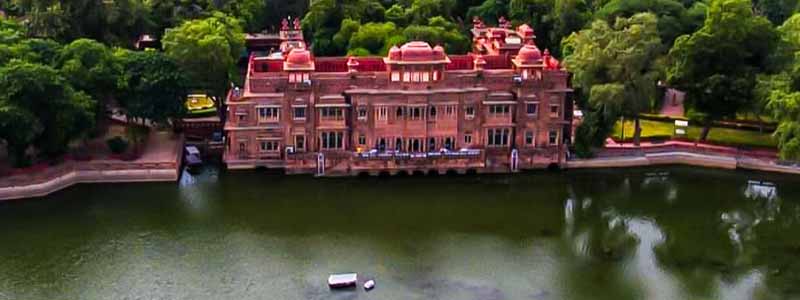
Bikaner – Havelis and More
Bikaner, a vibrant city in the northwestern state of Rajasthan, India, is renowned for its rich cultural heritage and architectural marvels. Among its most captivating attractions are the Havelis, opulent mansions that showcase the exquisite craftsmanship of yesteryears.
The Rampuria Haveli, a masterpiece of red sandstone, is a testament to the city’s opulence during the 15th century. Intricate carvings, jharokhas (overhanging balconies), and latticed windows adorn its façade, offering a glimpse into the grandeur of Rajputana architecture.
Another gem is the Laxmi Niwas Palace, a blend of Indo-Saracenic and European architectural styles. Built during the reign of Maharaja Ganga Singh, it exudes regality with its ornate interiors, majestic courtyards, and sprawling gardens.
The Bhandari Haveli, with its stunning frescoes depicting mythological and historical scenes, is a visual feast for art enthusiasts. It narrates stories of the city’s past, preserving the essence of Rajput culture.
Beyond Havelis, Bikaner boasts the Junagarh Fort, an impregnable fortress constructed with red sandstone and marble. Its grandiosity lies in its intricate carvings, ornate balconies, and intricately designed courtyards.
In addition to architectural wonders, Bikaner offers delectable cuisine, including the famous Bikaneri bhujia and sweets like rasgullas and ghevar.
Overall, Bikaner’s Havelis and architectural treasures serve as a living testament to the city’s royal past, offering a glimpse into the opulence and artistic finesse of a bygone era.
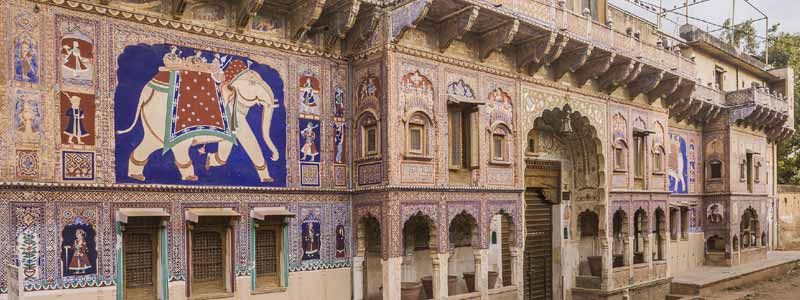
Shekhawati – The Open-Air Art Gallery
Shekhawati, often referred to as the “Open-Air Art Gallery,” is a region in the north-eastern part of Rajasthan, India. This unique destination is renowned for its exquisite frescoes and intricate murals adorning the walls of havelis (traditional mansions) and temples.
The artistry found in Shekhawati dates back to the 17th century, when wealthy merchants commissioned local and itinerant artists to embellish their homes. These frescoes showcase a fusion of artistic styles, including Mughal, Rajput, and European influences, depicting scenes from mythology, folklore, and daily life.
Each haveli is a testament to the opulence and artistic flair of the bygone era. Intricate patterns, vibrant colors, and detailed storytelling unfold on the walls, making it a visual feast for visitors. Notable towns like Mandawa, Nawalgarh, and Fatehpur are treasure troves of such architectural wonders.
Shekhawati’s open-air art gallery serves as a living testament to the artistic prowess of Rajasthan’s heritage. It offers a unique glimpse into the cultural, social, and historical milieu of the region. Today, efforts are being made to preserve and restore these masterpieces, ensuring that future generations can marvel at the intricate craftsmanship that graces the walls of Shekhawati. A visit to this open-air gallery is a journey back in time, a visual extravaganza, and an immersion into the rich cultural tapestry of Rajasthan.
Mount Abu – The Hill Station
Mount Abu is a picturesque hill station nestled in the Aravalli Range of Rajasthan, India. It stands tall at an elevation of 1,220 meters, offering a cool respite from the scorching desert climate of the region. This oasis of natural beauty is renowned for its lush forests, serene lakes, and stunning viewpoints.
The Dilwara Jain Temples, an architectural marvel, are a testament to the exquisite craftsmanship of ancient artisans. These temples, dating back to the 11th and 13th centuries, feature intricate marble carvings that leave visitors in awe.
Nakki Lake, surrounded by hills and legends, adds to the town’s charm. Visitors can enjoy boating or simply take in the tranquil atmosphere. To catch a breathtaking sunset, the Sunset Point is the place to be. The Honeymoon Point and the Toad Rock offer equally mesmerizing vistas.
Mount Abu also boasts a rich cultural heritage. The annual Summer Festival celebrates local traditions through folk performances, competitions, and a vibrant market.
With its cool climate, scenic beauty, and cultural richness, Mount Abu stands as a testament to the diverse tapestry of India, beckoning travelers seeking solace in the lap of nature.


